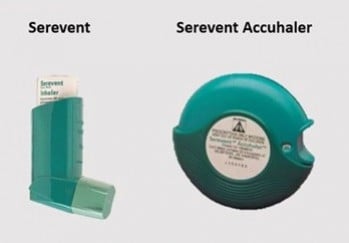Salmeterol
Sounds like 'sal-MET-er-all'
Key points about salmeterol
- Salmeterol is used to improve breathing problems caused by asthma and COPD.
- Salmeterol is also called Serevent®.
- Find out how to use it safely and possible side effects.

Salmeterol is used to improve breathing problems caused by asthma and COPD and to prevent them from recurring. It eases symptoms, eg, wheezing, coughing and shortness of breath. Salmeterol works by opening air passages in your lungs to make breathing easier.
- Salmeterol must be used every day. It's a long-acting bronchodilator, which means that it works throughout the day. It reduces your symptoms over the long term.
- For asthma, salmeterol should be used together with other medicines called corticosteroids, or preventers, eg, beclomethasone, budesonide or fluticasone.
In Aotearoa New Zealand, salmeterol is available in different brands and inhaler devices – metered dose inhaler (MDI or puffer) or accuhaler (a dry powder inhaler).

Using an inhaler device enables the medicine to go straight into your airways when you breathe in. This means that your airways and lungs are treated, but very little of the medicine gets into the rest of your body.
Both the MDI and accuhaler are effective. The choice of device is a personal preference. Read more about the different inhaler devices and how to decide on the right inhaler for you.
Salmeterol does not give immediate relief from an asthma attack.If you need quick relief from asthma symptoms, use your ‘reliever’ medicine such as salbutamol or terbutaline. |
- The dose of salmeterol will be different for different people depending on the severity of your symptoms and the strength of your inhaler or accuhaler.
- The usual dose of salmeterol is 1 or 2 inhalations twice a day.
- Always use your salmeterol exactly as your doctor has told you.
- The pharmacy label on your medicine will tell you how much to use, how often to use it and any special instructions.
Tips
- Keep using your inhaler every day. Don't stop using it, even if you feel better.
- Because asthma and COPD are long–term conditions, prevention with salmeterol is ongoing. You need to use it every day for months or years.
- Try to use your inhaler at the same time each day, to help you to remember to use it regularly.
- If you miss a dose, you can take it as soon as you remember. But if it's nearly time for your next dose, just take your next dose at the right time.
Use your MDI with a spacer
- A spacer is an attachment to use with your inhaler. It's a chamber that holds the medication before you inhale, giving you a more controlled, deeper inhalation. This can be especially helpful if you are short of breath.
- Using your MDI with a spacer makes it easier to use the inhaler and helps to get the medicine into your lungs, where it’s needed (with less medicine ending up in your mouth and throat).
- Read more about spacers.
Check your technique
- To get the most benefit from your inhaler, it's important to use the correct technique.
- Ask your healthcare provider to show you how to use your MDI and spacer devices.
- Even if you’ve been shown before, ask your healthcare provider to explain how to use your inhaler if you still have any questions.
The videos below provide some guidance on how to use a spacer with your MDI. Note: Your MDI or spacer may look different to the one in the videos below.
Video: How to use your spacer device
(Healthify He Puna Waiora, NZ and Auckland District Health Board, 2018)
Video: MDI and spacer
(Asthma Waikato, NZ, 2018)
To get the most benefit, it's important to use the correct technique. Ask your healthcare provider to show you how to use an Accuhaler®.
The video below provides some guidance on how to use an Accuhaler device. The Accuhaler is the name of the device used to deliver the medicine to your lungs and airways. There are different names for each Accuhaler depending on the medicines inside the device.
Your Accuhaler may be a different colour to the one in the video below. It's important to know the name and colour of your Accuhaler, eg, Flixotide®, Seretide® or Serevent®. Read more about understanding your medicines.
Video: How to use an Accuhaler inhaler
Source: NHS, UK, 2016
Using an Accuhaler device
- Open: Hold the Accuhaler in one hand, and with the thumb of your other hand push the thumb grip away from you until you hear a click. This reveals the mouthpiece.
- Load the dose: Hold the inhaler in a horizontal position. Slide the lever away from you until you hear a click.
- Breathe out: Breathe out, away from the Accuhaler. Don't blow directly into your device.
- Inhale your dose: Place the mouthpiece in your mouth and form a seal with your lips. Breathe in deeply and forcefully through your mouth. Remove the Accuhaler and hold your breath for up to 10 seconds. If you need another dose, wait for 30 seconds and then repeat the process.
- Close: Close the inhaler by sliding the thumb grip towards you.
Cleaning and storing an Accuhaler: Wipe the mouthpiece with a clean dry tissue. Don't wash the mouthpiece or let it get wet when cleaning. Close the device when not in use.
When to start a new Accuhaler: There's a window on the side of the Accuhaler called a dose counter. When it turns red, it's time to get a new Accuhaler.
Like all medicines, salmeterol can cause side effects, although not everyone gets them. Often side effects improve as your body adjusts to the new medicine.
| Side effects | What should I do? |
|---|---|
|
|
|
|
|
|
Read more about medicines and side effects and reporting a reaction you think might be a side effect.
Serevent accuhaler(external link) Medsafe Consumer Information, NZ
Serevent inhaler(external link) Medsafe Consumer Information, NZ
Salmeterol(external link) NZ Formulary Patient Information
Salmeterol in te reo Māori(external link) My Medicines, NZ, 2017
5 questions to ask about your medications(external link) Health Quality and Safety Commission, NZ, 2019 English(external link), te reo Māori(external link)
References
- Salmeterol(external link) NZ Formulary
Brochures

My Medicines, NZ, 2024

Medicines and side effects
Healthify He Puna Waiora, NZ, 2024
Credits: Healthify editorial team. Healthify is brought to you by Health Navigator Charitable Trust.
Reviewed by: Stephanie Yee, Pharmacist, Auckland
Last reviewed:
Page last updated:






